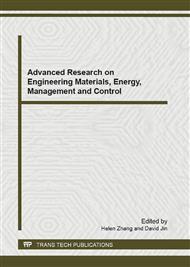[1]
JING L R. A review of techniques,advances and outstanding issues in numerical modeling for rock mechanics and rock engineering. International Journal of Rock Mechanics and Mining Sciences,2003,40(3): 283–353.
DOI: 10.1016/s1365-1609(03)00013-3
Google Scholar
[2]
HE Manchao, XIE Heping, PENG Suping. Study on rock mechanics in deep mining engineering [J]. Chinese Journal of Rock Mechanics and Engineering,2005,24(16): 2803–2813(in Chinese).
Google Scholar
[3]
BROWN E T, BRAY J W, LADANYI B, et al. Ground response curves for rock tunnels. Journal of Geotechnical Engineering, 1983, 109: 15-39.
DOI: 10.1061/(asce)0733-9410(1983)109:1(15)
Google Scholar
[4]
GUAN Z, JIANG Y, TANABASI Y. Ground reaction analyses in conventional tunneling excavation [J]. Tunnelling and Underground Space Technology, 2007, (22): 230-237.
DOI: 10.1016/j.tust.2006.06.004
Google Scholar
[5]
ALONSO E, ALEJANO L R, VARAS F, et al. Ground response curves for rock masses exhibiting strain-softening behavior. International Journal for Numerical and Analytical Methods in Geomechanics, 2003, (27): 1153-1185. (in Chinese).
DOI: 10.1002/nag.315
Google Scholar
[6]
LIANG Fayun, CHEN Longzhu. Analytical solution to cavity expansion in strain-softening soils with Tesca yield criterion and its applications. Rock and Soil Mechan ics, 2004, 25(2): 261-265.
Google Scholar
[7]
WANG Xiaohong, WANG Jialai, LANG Fayun. Analytical solution to expansion of cavity in strain-softening material. Engineering mechanics, 1999, 16(5): 71-76.
Google Scholar
[8]
ZHOU Jiawen, XU Weiya, LI Mingwei. Application of rock strain softening model to numerical analysis of deep tunnel. Chinese Journal of Rock Mechanics and Engineering , 2009, 28(6): 1116~1127(in Chinese).
Google Scholar
[9]
SHEN Xinpu, CEN Zhangzhi, XU bingye. The characteristics of elasto-brittle-plastic softening constitutive theory and its numerical calculation. Journal of Tsinghua University (Sci&Tech), 1995, 35(2): 22-27(in Chinese).
Google Scholar
[10]
ZIENKIEWICZ O C, TAYLOR R L. The finite element method. [S. l. ]: McGraw-Hill Book Company, (1991).
Google Scholar


